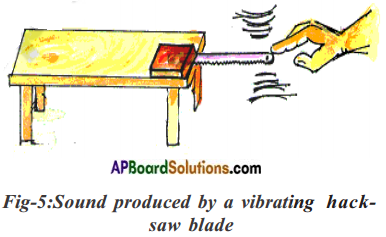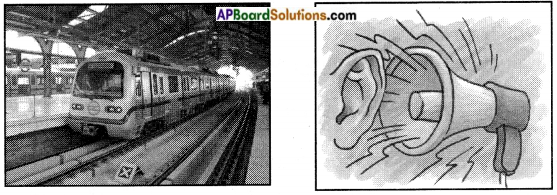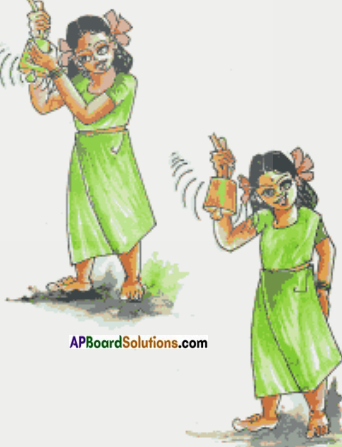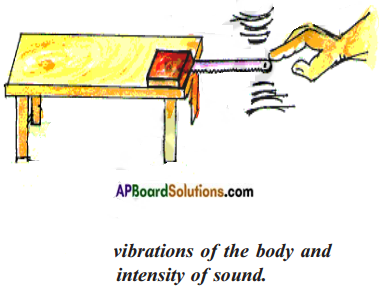AP State Syllabus AP Board 8th Class Physical Science Solutions Chapter 6 Sound Textbook Questions and Answers.
AP State Syllabus 8th Class Physical Science Solutions 6th Lesson Sound
8th Class Physical Science 6th Lesson Sound Textbook Questions and Answers
Improve Your Learning
Question 1.
Fill in the blanks with suitable words.
a) The to and fro motion of a body from its mean position is called ……… .
b) Number of vibrations per second is called ………. .
c) The intensity of sound can be measured in ……… .
d) Sound cannot travel in ………. .
e) Vibrating bodies produce ………. .
f) The maximum displacement of a body from its mean position is called ……… .
Answer:
a) vibration
b) frequency
c) Decibel
d) vacuum
e) sound
f) amplitude
![]()
Question 2.
A normal human being can listen to sounds with frequency from …….. to ……. vibrations per sec.
Answer:
20, 20000
Question 3.
How will you differentiate the amplitude and frequency of different sounds? Give two suitable examples from your daily life.
Answer:
The pitch of a sound depends upon sound whereas intensity of sound depends upon amplitude.
If we are hearing a loud sound that means it has greater amplitude.
If we are hearing a feeble sound that means it has least amplitude.
If the shrillness of sound is less then the frequency of the sound is less.
If the shrillness of sound is more then the frequency of the sound is more.
Examples for daily life:
Frequency:
- The shrillness of adult women is more than adult men because of greater frequency associated with vocal cords.
- The different sounds produced by whistle and drum are due to difference in frequencies.
- Amplitude:
- The difference in sound produced by lawnmower and car horn due to difference in their amplitude.
- The sound produced by crackers during Diwali is due to greater amplitude.
Question 4.
Write any three musical instruments that you know and explain how they produce sound? (OR)
Write any four musical instruments known to you and explain how do they produce sound.
Answer:
The three musical instruments are:
- Veena: This instrument contain strings of different thickness fixed on hollow wooden boards, with different tensions. When a string of certain thickness fixed under certain tension is vibrated which changing vibrating lengths different sounds are produced.
- Mridangam: It is in cylindrical shape and it containing membranes fixed with different tensions on the two sides. When it is vibrated by hand or by sticks at different places produce different sounds.
- Flute: It has a cylindrical tube open at both ends. It is provided with holes in a row on its surface. By blowing air through it, while changing the length of air column, different sounds are produced.
![]()
Question 5.
The sounds of crickets (insects) make us close our ears. Why?
Answer:
The sounds of crickets are shrill creaking which make us to close our ears.
Question 6.
Robert observed a musical instrument producing sound. But he didn’t find any vibration of any part of that instrument. This observation raised many questions in his mind. Can you guess what are the questions raised in his mind? Write them.
(OR)
Latha observed a musical instrument producing sound. But she did not find any vibration of any part of that instrument. This observation raised many questions in her mind. Guess the questions raised in her mind and write any two of them.
Answer:
- How does the instrument produce sound?
- Whether an object produce sound without any vibration?
- If it is producing vibration why do we unable to felt it?
- Does sound has energy?
Question 7.
“Vibrations in a body produce sounds”. How do you prove it?
Answer:
Put a hack-saw blade in between a table and brick as shown in figure and press it and leave it abruptly. It produces sound and we observe hack-saw blade is vibrating. Which proves a vibrating body produces sound.

Question 8.
Can parrots speak? Discuss with your Mends and collect information.
Answer:
Yes, parrots can speak. But parrot do not have vocal cords, so sound is accomplished by expelling air across the mouth of the bifurcated trachea. Different sounds are produced by changing the depth and shape of trachea. So talking or speaking of parrots are really whistling in different variation. Parrots speak without understanding words.
![]()
Question 9.
Collect the photographs of local musicians and exhibit them in your class.
Answer:

Question 10.
Collect photographs showing various situations of sound pollution and prepare a scrap book.
Answer:



Question 11.
Zakir said “vibrations produce sound. And sound produces vibrations. This is how we hear every sound”. Establish that the given statement is true with relevant examples from your surroundings.
Answer:
Examples for vibrations produce sound :
- Fix a rubber band tightly on an empty match box. Pluck the rubber band and keeping it near to our ear we can hear sound that shows vibrating object produce sound.
- A vibrating hack-saw blade placed between a table and brick produces sound. Which is also an example for vibrating body produces sound.
Examples for sound produces vibration:
- Sound produced by supersonic planes vibrates the wall of buildings and glass windows due to which we can observe the cracks on the walls or breakage of windows.
- Take a cell phone and playing music with high volume in a plastic bottle. Close the mouth of bottle with a balloon using rubber band and place sugar crystals above the bottle. We can observe the vibrations of sugar crystals.
![]()
Question 12.
Make different musical instruments using local available materials and exhibit them in your class.
Answer:
- Jalatarang: Take 4 to 5 metal or glass bowls or tumblers. Fill them with water in increasing order. Strike gently each bowl or tumbler with a spoon. We can produce different musical sounds. So it acts as Jalatarang.
- Two note flute: Get a jug or bottle. Cut a smaller than finger sized hole in the bottom of the bottle / jug. Blow across the hole that is already in the top of the jug/ bottle until you get a clear note. Cover and uncover the hole on the bottom with your finger. You can also try tilting your head down and up to make the note sharp or flat.
- Drum: Get a plastic paint barrel. Put it on the ground between your feet or in the crook of your elbow. Play it like a drum.
- Guitar: Take empty shoe box and cut a circle in the middle. Cut six rubber bands so that they can be stretched out to their full length. Press brass fastners into the shoe box placing six on the top and six on the bottom of the box. Stretch out the rubber band, one at time, tying them onto the fastners. Cut a paper roll in half and slide in underneath the rubber bands below the hole. Which will act as guitar.
Question 13.
Explain why we are not able to hear the explosions taking place in the sun.
Answer:
Sound wave cannot travel in vacuum (meaning space). In order to hear sound waves it must required medium. So we are not able to hear explosions happening in the sun.
Question 14.
Write any two slogans to reduce sound pollution.
Answer:
Slogans to reduce sound pollution:
- The more you make noise. The faster you lose your voice.
- Noise an evil. You help doing it, it gives you a reward making you a deaf.
Question 15.
Write your suggestions about reducing sound pollution.
Answer:
- Attach silencers to bikes and other machines to reduce sounds.
- Manufacture machines that work with less noise.
- During the use of TV and taperecorder tune down volume of sound.
- Plant trees to reduce sound pollution.
- Community laws must. Silence zones near school/colleges, hospitals, etc.
- Noise producing industries, airports, bus and transport terminals and railway stations to sighted far from living places.
![]()
Question 16.
How does sound pollution effects bio – diversity? Explain.
Answer:
Slogans to reduce sound pollution:
- The more you make noise. The faster you lose your voice.
- Noise an evil. You help doing it, it gives you a reward making you a deaf.
Effects of sound pollution on bio-diversity:
- The first harmful effect is loss of hearing.
- It also leads to several health related problems, e.g: Sleeplessness, hypertension, increase in blood pressure, etc.
- It effects the mental health of people.
- In animals, noise can increase the risk of death by altering predator or prey detection and avoidance, interfere with reproduction and navigation and contribute to permanent hearing loss.
- Noise pollution causes poor quality of crops.
- Under water animals such as whales and dolphins too experience discomfort due to noise pollution caused by submarines, shipping companies and sonars. Cuttle fish and octopus suffer serious damage from noise pollution.
8th Class Physical Science 6th Lesson Sound InText Questions and Answers
Think and Discuss
8th Class Physical Science Textbook Page No. 86
Question 1.
What is the effect of humidity on quality of sound propagation? Is there any difference in propagation of sound in air during the summer and winter seasons? Discuss with your Mends.
Answer:
With increase in humidity, density of air decreases. So with rise in humidity velocity of sound increases.
This is why sound travels in humid air (rainy season or winter) than in dry air (summer) at the same temperature.
8th Class Physical Science Textbook Page No. 87
![]()
Question 2.
“Vibrations produce sound and sound produces vibrations”. Which is true in this? Discuss.
Answer:
Yes, it is true. We already know a vibrating object produce sound. Sound is a mechanical wave that can produce vibration. (Mechanical waves have ability to vibrate an object)
Question 3.
“Our ear has the three media through which sound propagates.” Discuss with your Mends as to whether the above statement is true.
Answer:
Yes, it propagates through three media. The first media is external ear, the second media is middle ear, the last media is inner ear.
8th Class Physical Science 6th Lesson Sound Activities
Activity – 1
Question 1.
Listening to sound and predicting its source:
Let us sit quietly for a while and listen to sounds of objects, animals. Prepare a list of sounds that we hear and the sources from which they might have originated. Write them in the table.
Answer:
| Sound heard | Source of sound |
| Feeble barking | Dog from some distance |
| Bell ringing | School bell |
| Music | Radio / TV |
| Noise | Students in a classroom |
| Horn | Bike / car |
| Whistle | A student has produced sound from his / her mouth |
Activity – 2
Question 2.
Identifying different sounds:
Make a student to stand at the blackboard such that his face is turned towards the blackboard and ask other student in the class to make different sounds. The student at the board should tabulate the sounds he heard and sources of those sounds as shown in the table.
| Sound heard | Way of producing sound |
| Gala Gala | A few stones rattling in a metal box |
| Eela (whistling sound) | A student has produced the sound from her/his mouth |
| Tapa Tapa | Someone one striking the table tab with a scale |
| Taka Taka | Someone thumping the ground with shoes |
| DabaDaba | Someone knocking at the door |
| Paka Paka | Someone is laughing |
a) How does the student at the blackboard guess the source of sound without actually seeing the source?
Answer:
Student has identified the variations in sound by listening.
b) How do objects produce sound?
Answer:
When we vibrating the objects, they produce sound.
![]()
c) What happens when objects made of metals are hit by a hammer or fall down from a height on a concrete floor ?
Answer:
When objects made of metals are hit by hammer from a height, they produce sound.
d) How does a flute or a whistle produce sound?
Answer:
Vibration of air column produce sound in flute or whistle.
e) How would you feel if you touch a body while it is producing sound?
Answer:
My body is vibrating when I touch a body (or object) while it is producing sound.
Activity – 3
Question 3.
Vibrating body produces sound:
Take a brass bell (bell used in Pooja room or in your school).
Ring the bell and listen to the sound carefully. Now hold the bell tightly with your hand as shown in figure and ring it again.

a) Do you hear sound from the bell ?
Answer:
Yes, but slightly.
b) Is there any change in the sound produced in the two situations?
Answer:
Yes, in the second case the sound is feeble.
c) What do your hands feel when bell is ringing?
Answer:
The hand vibrates.
d) Remove your hand and ring it again. Do you hear a different sound? Why?
Answer:
Due to the vibrations are transmitted to hand and bell is not properly vibrating so it produces a feeble sound. Once the hand is removed bell rings properly and sound become louder and different.
Let us do following activities:
e) Fix a rubber band tightly on an empty matchbox. Pluck the rubber band and keep it close to your ear. Do you hear any sound? Do you feel any vibration in your hands?
Answer:
Yes, I heard a sound. I felt the vibration.
![]()
f) Blow air into papers of your notebook. What happens? Does the action produce any sound? Do you find any vibrations in the note book?
(OR)
If you blow air into papers of your notebook, sound will be produced. Write your observation in this activity.
Answer:
Yes, it produce sound and I found vibrations in the notebook.
g) Fill a plate with water and let the water settle. Strike the rim of the plate with a spoon as shown in figure. What do you observe? What do you hear? Where do you find vibrations in this case?

Answer:
I heard a sound. The vibrations are found in plate as well as in water.
h) Put a hack-saw blade in between a table and a brick as shown in the figure and press it and leave it abruptly. What happens? Does it produce sound? What is the state of the hacksaw blade while it is producing sound?

Answer:
Yes, it produces sound. The blade is vibrating.
i) What have you observed while doing the above activities?
Answer:
All of them produced sound.
j) What changes took place in those objects?
Answer:
These objects are vibrate while producing sound.
But there are certain instruments which producing sound though we cannot see any vibrations in the instruments like in flute and clarinet etc.
k) How do they produce sound?
Answer:
They are producing sound due to vibration of air column.
l) Is it possible to produces sound without vibration?
Answer:
No, it is not possible to produce sound without vibration.
m) Does every vibrating body produce sound?
Answer:
Yes, every vibrating body produce sound.
n) Does sound has energy?
Answer:
Yes, sound has energy.
![]()
Activity – 4
Question 4.
Sound has energy: (OR)
Suggest an activity to prove “sound has energy”.
Take a plastic bottle and a cell phone. Cut the top of the bottle so that it looks like a glass. Play songs on the mobile phone in high volume and place it in the bottle. Close the mouth of bottle with a balloon using rubber band so that it covers the bottle as shown in the figure and stretch it tightly so as to behave like a diaphragm. Place some sugar crystals or small size of sand particles on the balloon diaphragm and observe the movement of particles. Do the same activity after removing the phone from the bottle.

a) What do you notice?
Answer:
When there is no cell phone inside the bottle, sand particles on diaphragm remain stationary. While the cell phone playing songs inside the bottle, the diaphragm vibrates which can be seen through dancing of sand particles. The sound produced by cell phone inside the bottle is responsible for these vibrations. Thus sound has energy to make sand particles vibrate on the diaphragm.
Musical instruments:
You might have observed many musical instruments like Tabala, Flute, Harmonium and Guitar. The sounds produced by these instruments are distinct. It is easy for us to identify which sound is coming from which instrument.
b) How do they produce sound?
Answer:
They produce sound due to vibration.
c) Why there is a difference between the sounds produced by various musical instruments?
Answer:
The mode of vibration is different.
d) Which part of these instruments is responsible for production of sound?
Answer:
Different parts for different instruments:
| Name of instrument | Vibrating part of it |
| Tabala | Membrane, air inside hollow body |
| Veena | String fixed on hollow wooden board |
| Flute | Air columns |
| Clarinet | Air columns |
| Guitar | String fixed on hollow wooden board |
| Mridangam | Membrane, air inside hollow body |
e) Can you name the instrument for which more than one part is responsible for the production of sound?
Answer:
Tabala, Mridangam.
![]()
f) How do you compare the production of sound in a flute and sound produced in a water tap when it is turned on, just before the water flows out of it.
Answer:
Both are same process. They produce sounds due to vibrating air columns.
Activity – 5
Question 5.
Producing a sound that resembles sound of rainfall:
Start clapping with fore finger on left hand palm, add the middle finger and clap again, then ring finger and lastly small finger successively and reverse the process gradually. If all the students in your class do it simultaneously the sounds produced would resemble the on set and stopping of rainfall.
Activity – 6
Question 6.
Observing the changes in sound:
Take 4 or 5 metal glass bowls or tumblers. Fill them with water in decreasing order. Strike gently each bowl or tumbler with a spoon.

a) What do you hear?
Answer:
We can hear a musical sound. This is a jalatarang.
Fill the bowls or tumblers with equal amounts of water, strike each ball like in above case and listen the sound.
b) What difference do you notice in the sound produced?
Answer:
It does not produce musical note in this case.
c) Why is there variation in the sound produced due to change in the water level of a bowl?
Answer:
The change is due to change in air columns. That is sounds are produced by the vibrating bodies and air passes through orifices of the instrument.
![]()
Activity – 7
Question 7.
Observing the movements of vocal cords during speech :
Ask a friend to raise his neck up. Stretch a chocolate wrapper across his mouth and ask him to blow air on the wrapper forcibly. Observe the changes in movement at his throat. Ask him to blow again slowly and observe the difference in movements.
a) What changes do you observe in the movements at the throat on the two occasions?
Answer:
During the first trial the voice box gets tensed and produces high sound while during the second trial it is close to normal position of throat and produces lower sound. The sound produced in the above activity is due to a combination of vibrations produced in the wrapper and the vocal cord.
Propagation of sound:
Sound needs a medium to propagate:
The sound produced by the school bell will be heard by all of us irrespective of whether we are in a room opposite to the bell or in a room at the back of the bell. Obviously, the sound produced by the school bell travels in all directions and reaches us, propagating through the air present between source of the sound and our ears. That is the air surrounding us act as a medium which allows the sound to pass through it.
b) Does sound travel only in air?
Answer:
No, it will travel in other media.
c) Does it travel in any other gaseous medium?
Answer:
Yes, it will travel in any other gaseous medium.
d) Does sound also travel in other media like solids and liquids?
Answer:
Yes, it will travel.
Activity – 8
Question 8.
Observing sound propagation in solids:
Strike one end of the table with a pen and ask your friend to listen to the sound produced keeping her ear touching the table at other end and also ask her to listen to the sound by lifting her head slightly from the table. Ask your friend what difference she noticed while hearing the sounds when her ears were away from the table and touching the table.

Take a metal or wooden strip. Strike it at one end and ask your friend to hear the sound by keeping his ears at the other end of the strip. Ask your friend what difference he noticed while hearing the sounds when his ears are away from the strip and touching the strip.

a) Do you know how to make a toy telephone using tea cups?
Answer:
Take two paper-cups. Make small holes at the bottom of these cups. The holes should be very small so that only a thin string can pass through them. Take a long string. Make sure that the string does not have any knots in it. Push the string through the hole in one of the cups. Fix the string by putting a knot at the end. Similarly fix the string to the other cup. Our phone is ready.

You and your friend can communicate with this phone now. Stand away from each other so that the string is tightly held. One of you can speak in the cup while the other can listen by putting the cup on his ear.
b) Are you able to hear the sound?
Answer:
Yes, we can hear the sound.
c) What is a medium between you and your Mend which is responsible for propagation of sound?
Answer:
The medium is thread.
In the above activities you observed that sound travels in solid medium like wood, metal, thread, etc.
![]()
Activity – 9
Question 9.
Propagation of sound through liquids:
Take a bucket fill it with water. Take two stones and strike them against each other keeping your hands inside the water. Ask your friend to listen to the sound by keeping his / her ears touching walls of the bucket.

Ask your friend about the difference between sounds produced by striking the stones against each other in water and striking them in air.
Thus the conclusion is that sound propagates through matter in all the three states – solid, liquid and gas.
a) Does sound travel in liquids?
Answer:
Yes, sound can travel in liquids.
b) Can we hear the sound produced in water?
Answer:
Yes, we can hear.
Activity – 10
Question 10.
Does the sound travel if there is no medium?
Take a water tumbler or a glass made of plastic or glass. Make sure that the tumbler or the glass is dry. It should be long enough to accommodate a cell phone vertically. Place a cell phone small in size in the glass and play the ring tone of the mobile. Listen to the ringtone and its volume level. Cover the glass with a small plate and again listen to the ringtone and note the difference in volume of the sound.

Now suck the air from the glass keeping it close to your mouth. If you suck air quickly the rim of the glass will stick around your mouth due to air lock. Listen to the volume of the ringtone at this stage. And also ask your friend to listen to the sound for comparing variation in its volume.
a) Is there any change in the volume of sound observed by you or your Mend?
Answer:
When the tumbler is covered with a plate, the volume reduces but you can hear the ringtone. As we start sucking more and more we can notice that the volume decreases gradually. If the air is sucked completely, you will not hear the sound at all. But practically it is not so easy.
This activity gives an idea about need of a medium for propagation of sound.
Lab Activity – 1
Question 11.
Conduct an experiment to know the relationship between the intensity of sound produced by a body and the vibration of the body.
Answer:
Aim: To know the relation between the intensity of sound produced by a body and the vibrations of the body.
Materials required: Wooden table, 30 cm metal scale or nearly 30 cm hack-saw blade and a brick.
Procedure:
Place the blade/scale on the table, with 10cm of the blade on the surface of the table and rest of it in air. Keep a heavy brick on one end of the 10 cm blade/ scale kept on table.

Vibrate the blade gently and observe the vibrations and simultaneously listen to the sounds. Repeat the same 2-3 times and record observations in the table shown below.
Vibrate the blade using greater force. Observe the vibrations and listen to the sound. Repeat this for 2-3 times and record your observations in the table shown below.
| Force | Vibrations of the. blade / scale | Intensity of sound |
| Small | 50 | Less |
| Large | 50 | More |
a) When do you hear a loud sound?
Answer:
When we applied large force we heard a loud sound.
b) When do you hear a feeble sound?
Answer:
When we applied less force we heard a feeble sound.
c) What difference do you notice in vibrations of blade / scale during loud and feeble sounds?
Answer:
During loud sound the amplitude of vibration is more and for feeble sound the amplitude is less.
d) What difference do you find in amplitude of vibration for a feeble and a loud sound in the above experiment?
Answer:
For a loud sound the amplitude is more and for a feeble sound the amplitude is less.
![]()
Lab Activity – 2
Question 12.
Explain identification of pitch or shrillness of sound with the help of an activity.
(OR)
What are the characteristics of sound? Explain the procedure to identity the pitch of sound.
Answer:
Chardcteristics sound are 1) Loudness 2) Pitch 3) Quality.
Aim: Identifying pitch or shrillness of a sound.
Materials required: A wooden table, two hack-saw blades or metal scales of 30cm length and a brick.
Procedure:
Place the first blade/scale on the table, with 10cm portion of the blade on the table and rest of it in air. Keep a brick as weight on the 10 cm portion of the blade/scale kept on the table. Vibrations of hack-saw blades
Place the second blade/scale on the table (see that the gap between these two blades is 10cm), with 25cm on the table and 5cm in air. Keep a brick as weight on the scale/blade.

Vibrate both blades with same force. Observe the vibrations and listen to the sounds produced.
Repeat the same 2-3 times and record observations in the table showed below.
| Blade length in air | Vibrations | Sound |
| Blade 1 : 20cm | 50 | Less shrillness |
| Blade 2 : 5cm | 90 | More shrillness |
a) What difference do you notice in number of vibrations of two blades?
Answer: The number of vibrations in 5 cm blade is more.
b) What difference do you notice in the quality of sound produced by them?
Answer:
The sound produced by 5 cm blade is more shrill when compared to that of 20 cm blade.
